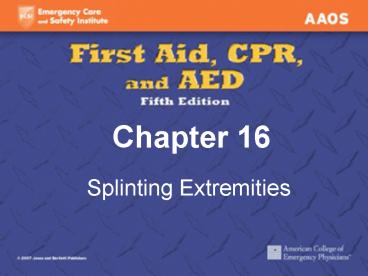Splinting Extremities - PowerPoint PPT Presentation
1 / 25
Title:
Splinting Extremities
Description:
Applying a Sling to Upper Arm, Forearm, or Hand/Wrist (1 of 2) ... Improvised Slings. Place hand inside ... Place arm in sling and swathe with thumb upright. ... – PowerPoint PPT presentation
Number of Views:269
Avg rating:3.0/5.0
Title: Splinting Extremities
1
Chapter 16
- Splinting Extremities
2
Splinting
- Reduces pain
- Prevents further damage to muscles, nerves, and
blood vessels - Prevents closed fracture from becoming open
fracture - Reduces bleeding and swelling
3
Types of Splints
- Rigid splint
- Self-splint (anatomic splint)
- Soft splint
4
Splinting Guidelines (1 of 3)
- Cover open wounds with dry dressing before
applying splint. - Check CSM in the extremity.
- Splint only if it wont cause further pain.
- Splint in position found.
- Warn victim of pain.
- Use splint that will extend beyond joints above
and below injury. - Apply firmly, but do not affect circulation.
5
Splinting Guidelines (2 of 3)
- When possible, splint on both sides of injury.
- Check CSM periodically.
- Elevate extremity after splinting.
- Apply ice pack.
- If possible spine injury, victim should not move.
- Stabilize spine with rolled blankets on each side
of neck and torso.
6
Splinting Guidelines (3 of 3)
- Seek medical care if
- Extremity has no pulse
- Open fracture
- Dislocation
- Swollen, hot, tender, or painful joint
- Deformity, tenderness, swelling over bone
- Victim unable to walk
- Snap, crackle, pop was heard
- Uncertain whether bone was broken
- Lack of rapid improvement
7
Slings
- Open triangular bandage sling
- Folded triangular bandage cravat/swathe
8
Applying a Sling to Upper Arm, Forearm, or
Hand/Wrist (1 of 2)
- Hold victims arm away from chest.
- Place triangular bandage between forearm and
chest with point toward elbow. - Stretch bandage beyond elbow.
- Pull upper end of bandage over uninjured
shoulder. - Bring lower end of bandage over forearm.
9
Applying a Sling to Upper Arm, Forearm, or
Hand/Wrist (2 of 2)
- Bring end of bandage around neck to uninjured
side. - Tie other end at hollow above clavicle on
uninjured side. - Place swathe around upper arm and body.
- Place padding underneath both knots.
- Adjust sling to support hand and wrist.
10
Applying a Sling to Clavicle/Shoulder (1 of 2)
- Hold victims arm away from chest.
- Place triangular bandage between forearm and
chest with point toward elbow. - Stretch bandage beyond elbow.
- Pull upper end over uninjured shoulder.
11
Applying a Sling to Clavicle/Shoulder (2 of 2)
- Bring lower end of bandage over forearm.
- Tuck under armpit on uninjured side.
- Bring lower end around back.
- Tie to upper end.
- Place swathe around chest and forearm.
12
Improvised Slings
- Place hand inside buttoned jacket.
- Use belt, necktie, or other item looped around
neck and injured arm. - Pin sleeve of shirt or jacket to clothing.
- Turn up lower edge of shirt or jacket over
uninjured arm. - Pin to upper part of shirt or jacket.
13
Shoulder Splinting (1 of 2)
- Support injured arm away from chest.
- Place open triangular bandage between forearm and
chest. - Stretch point beyond elbow.
- Pull upper end over shoulder on uninjured side.
14
Shoulder Splinting (2 of 2)
- Bring lower end over forearm, under armpit on
injured side, around back. - Tie upper and lower ends.
- Check pulse and nail color.
15
Humerus Splinting
- Place injured arm across chest.
- If available, tie rigid splint to outside of arm.
- Place arm in sling.
- Secure arm to chest with swathe.
16
Elbow Splinting
- Splint in position found.
- If straight, tie rigid splint onto arm with
cravat bandages. - Place arm in sling.
- Check CSM.
17
Forearm Splinting
- Use one rigid splint from palm past elbow.
- Use second rigid splint on opposite side of arm.
- Secure splint with roller bandage or cravats.
- Put arm in sling.
- Keep thumb upright.
- Secure with swathe around body.
18
Wrist, Hand, and Finger Splinting
- Three methods
- Place injured hand in position of function.
- Attach rigid splint extending past fingertips.
- Place hand in position of function.
- Place arm in sling and swathe with thumb upright.
- Tape fingers together with gauze separating
fingers.
19
Pelvis and Hip Splinting
- Stabilize victim in position found.
- Treat for shock.
- Do not lift legs.
- Wait for EMS.
20
Femur Splinting
- Traction splint required.
- Available only on ambulances.
- Two first aid methods
- Place folded blanket between victims legs.
- Place board between legs from groin to foot.
21
Knee Splinting (1 of 2)
- Stabilize in position found.
- To splint straight knee
- Lift injured leg.
- Place rigid splint under leg, from buttocks to
beyond foot. - Place cravats under splint.
- Place padding under knee and ankle.
- Tie cravats. Do not tie over injured area.
22
Knee Splinting (2 of 2)
- To splint bent knee
- Place rigid splint against injured leg.
- Do not place against knee.
- Tie cravat around splint and lower leg.
- Tie cravat around splint and thigh.
- Tie knots over splint, not over leg.
23
Lower Leg Splinting (1 of 2)
- Self-splint method
- Pad between legs.
- Push cravats under leg with thin board.
- Tie legs together.
- Tie knots between legs, over padding.
24
Lower Leg Splinting (2 of 2)
- Using rigid splints
- Place rigid splint on outside and inside.
- Push cravats under leg and splints with thin
board. - Tie splints and leg together with cravats.
- Tie knots on top of splint.
25
Ankle and Foot Splinting
- Use RICE.
- Wrap pillow or folded blanket around ankle and
foot. - Tie with cravats.































